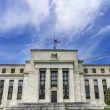The last FOMC (Federal Open Market Committee) meeting, which occurred on May 3, saw the tenth rise in interest rates in a row.
In its official statement, the Committee removed the reference to possible rises in the near future, something that allowed optimism to spread across analysts.
Despite this, Jerome Powell’s words during the press conference overshadowed that optimism: the chairman affirmed that the Fed is ready to take the necessary measures to fight inflation – implying other possible interest rates rises. The stock market fell, and many regional banks were involved – the failure of First Republic didn’t help.
The latest FOMC meeting sent contradictory signals and regional banks fell
Despite the optimism that spread across analysts after the latest FOMC meeting, which showed that the interest rates rise pressure should be limited in the near future, markets didn’t react accordingly. Interest rates were raised by another 25 basis points, and it was the tenth time they were raised since March 2022.
Right after the meeting held on May 3, 2023, and the press conference that sent contradictory signals because of the words of Jerome Powell, chairman of the Federal Reserve, S&P 500, Nasdaq and Dow Jones falled.
The same occurred to regional banks. Regional banks are defined as banks that hold between $10 billion and $100 billion in assets.
After the collapse of First Republic Bank, which was recently partially acquired by JP Morgan, Powell also addressed the US banking system.
According to the Fed chairman, the banking system in the U.S. is “sound and resilient”, but it looks like shareholders are not as optimists as Powell.
Similar words were pronounced by Janet Yellen in April: according to the U.S. Treasury Secretary, the banking system of the United States – which might imply a reference to the global financial system – remained resilient despite the bank collapses that hit the country – especially for what concerns the banks most involved in the tech industry.
The collapse of First Republic Bank was the third collapse of a major bank in the U.S. in just two months.
What happened to First Republic
First Republic Bank was a California-based bank founded in 1985.
First Republic was acquired by Merrill Lynch in 2007, and then sold after the 2008 crisis, marking a new beginning for First Republic – which was acquired by Bank of America Corp. and listed on the NYSE.
Amidst the recent banking crisis that hit the U.S. banking system, the bank was seized by regulators – as in the case of Silicon Valley Bank, most of the deposits of the bank were uninsured. Most of the assets were bought by JP Morgan Chase, and the NYSE announced that it will delist First Republic shares.
As reported by the CBS, JP Morgan Chase, after acquiring around $185 billion-worth of First Republic assets, “is now the largest depository institution in the U.S.”.
Following one of the most important bank collapses – the collapse of Silicon Valley Bank – the Fed started analyzing the banking system, and in a report produced by Michael Barr, the vice chairman for supervision of the Federal Reserve, part of the blame has to be assigned to the deregulatory policy adopted by Trump.
What are the regional banks the fell after the FOMC meeting
After the last FOMC meeting and the market downturn that followed Powell’s speech, the shares of some U.S. banks dropped.
Among them, PacWest Bancorp (PACW), which lost around 50%; Western Alliance Bancorp (NYSE: WAL), which lost over 50% and denied all the rumors about a possible sale.
The S&P Regional Banking ETF lost over 5%. Top banks were affected too, with JP Morgan Chase (JPM) losing around 3% – after a rally on May 3; Goldman Sachs (GS) losing over 4%; Bank of America (BAC) losing over 7%; Wells Fargo (WFC) losing over 7%.
In the meantime, concerns related to a recession and the unemployment rate rise – jobless claims arose from 229,000 to 242,000.
WeInvests is a financial portal-based research agency. We do our utmost best to offer reliable and unbiased information about crypto, finance, trading and stocks. However, we do not offer financial advice and users should always carry out their own research.
Read More









